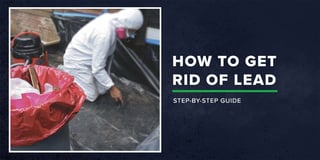How to get rid of lead paint: A step-by-step containment and disposal guide

Lead paint disposal is a critical process that requires careful attention to safety, compliance, and environmental responsibility. Whether you’re a professional sandblaster or a DIY enthusiast, following proper steps is essential to protect yourself and others while staying within the law. This guide walks you through the key steps to safely and effectively dispose of lead paint waste.
Step-by-Step Guide to Lead Paint Disposal
1. Identify Lead Based Paint

Before starting, confirm that the paint contains lead. Use a lead testing kit or hire a professional inspector to assess the area with a paint analyzer(shown above). Knowing what you’re dealing with ensures you take appropriate precautions.
2. Set Up Containment

Contain the worksite to prevent the spread of lead dust and debris. Use methods such as:
-
Full enclosures with rigid or flexible barriers.
-
Negative air pressure systems with HEPA filtration.
-
Ground coverings like heavy-duty tarps to catch falling debris.
-
Access restrictions to secure the area from non-workers.
For more information, read our article on Containment and Cleanup Tips for Sandblasters.
3. Wear Proper PPE

Equip yourself with personal protective equipment, including respirators with HEPA filters, disposable coveralls, gloves, and safety goggles. This minimizes your exposure to hazardous lead particles.
4. Remove and Collect Waste

Use sandblasting, dustless blasting, or other approved removal methods to strip lead paint. Immediately collect all waste, including paint chips, dust, and used PPE. Place them in heavy-duty, leak-proof bags or containers labeled as "Lead-Contaminated Waste." Store waste in a secure area away from weather exposure and restrict area access to prevent spills or other accidents.
For more information, consult OSHA's Lead in Construction Standard.
5. Test for Hazardous Waste
You may need to conduct yourself or pay for a Toxicity Characteristic Leaching Procedure (TCLP) test to determine if the waste is classified as hazardous. Hazardous waste (lead content ≥ 5 mg/L) must follow specific disposal procedures.
For more information, refer to the EPA's guidelines on waste generated by contractors and also to your local laws and regulations regarding LBP (lead based paint) disposal.
6. Transport to an Approved Facility

For hazardous waste (where lead content ≥ 5 mg/L), use a certified hauler to deliver materials to a licensed treatment, storage, and disposal facility (TSDF). Non-hazardous waste may be taken to approved construction and demolition landfills, based on local guidelines.
7. Clean Up Thoroughly
After removing the waste, clean the worksite using HEPA vacuums and wet cleaning methods. Decontaminate tools and equipment to ensure no residual lead remains.
8. Document Everything
Keep records of waste testing, transport, and disposal. Proper documentation demonstrates compliance with regulations and provides valuable reference material.
Additional Resources
Final Thoughts
Disposing of lead paint safely and legally is a crucial part of any abatement project. For sandblasters, this skill can open doors to profitable opportunities in a specialized market. For DIYers, proper disposal protects your health and the environment. Remember, this guide is a starting point. Always consult your local laws and regulations for specific requirements.
Stay informed, stay safe, and take the necessary steps to handle lead paint responsibly.
